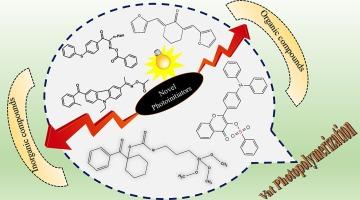An overview on potential of novel photoinitiators for vat photopolymerization-based 3D/4D printing formulations
IF 5.8
2区 化学
Q1 POLYMER SCIENCE
引用次数: 0
Abstract
In recent years, three-dimensional (3D) printing has emerged as an outstanding technique for creating intricate 3D structures with complex geometries. Additionally, four-dimensional (4D) printing technology has attracted attention due to its ability to reshape of 3D printed structures under external stimuli over time. The application of this technique in various fields such as polymer recycling, coating, energy storage systems, medical tools, and hydrogels is due to recent advances in functional materials. Vat photopolymerization-based 3D (VP-based 3D) printing relies on photopolymerization reactions, which are commonly used in techniques such as digital light processing (DLP) and stereolithography (SLA). These techniques are associated with critical parameters such as curing kinetics, printing speed, and resolution. Photoinitiators (PIs) as one of the components of the formulation of photo-resins and photo-inks can be very effective in optimizing these parameters. There are challenges in using common photoinitiators, such as yellowing effect, migration to the surface, toxicity, and bio-incompatibility. To address these challenges, recent researches have been directed towards the synthesis of new photoinitiators based on bio-inspired compounds, inorganic particles, aliphatic structures, transition metals, fluorescent compounds, photo-sensitizers, and macro-structure-based photoinitiators. This review article aims to explore recent studies on the synthesis of new photoinitiators in the application of 3D and 4D printing. Also, it examines various chemistries in the design of photoinitiators and describes the relationship between the curing kinetic, type of monomers, and printing speed. Moreover, it highlights the potential of synthesized photoinitiators in addressing challenges with mechanical properties, resolution, and transparency of the printed part. Furthermore, this article effectively categorizes various types of photoinitiators based on organic and inorganic compounds. Finally, the article aims to generate interest and stimulate more research in the use of new photoinitiators in industrial applications and formulation towards sustainable 3D and 4D printed structures.

新型光引发剂在基于大桶光聚合的 3D/4D 打印配方中的应用潜力综述
近年来,三维(3D)打印技术已成为制造复杂几何形状的三维结构的杰出技术。此外,四维(4D)打印技术因其能够在外部刺激下随时间重塑三维打印结构而备受关注。这种技术在聚合物回收、涂层、储能系统、医疗工具和水凝胶等多个领域的应用,得益于功能材料的最新进展。基于大桶光聚合的三维打印(VP-based 3D )依赖于光聚合反应,而光聚合反应通常用于数字光处理(DLP)和立体光刻(SLA)等技术中。这些技术与固化动力学、打印速度和分辨率等关键参数有关。光引发剂(PI)作为光树脂和光墨水配方的成分之一,可以非常有效地优化这些参数。在使用普通光引发剂的过程中存在一些挑战,如黄化效应、向表面迁移、毒性和生物相容性。为了应对这些挑战,最近的研究方向是合成基于生物启发的化合物、无机颗粒、脂肪族结构、过渡金属、荧光化合物、光敏剂和基于宏观结构的光引发剂。这篇综述文章旨在探讨在三维和四维打印应用中合成新型光引发剂的最新研究。此外,文章还探讨了光引发剂设计中的各种化学成分,并描述了固化动力学、单体类型和打印速度之间的关系。此外,文章还强调了合成光引发剂在应对打印部件的机械性能、分辨率和透明度等挑战方面的潜力。此外,本文还根据有机和无机化合物对各类光引发剂进行了有效分类。最后,文章旨在激发人们对新型光引发剂在工业应用和配方中的使用的兴趣,并推动更多研究,以实现可持续的三维和四维打印结构。
本文章由计算机程序翻译,如有差异,请以英文原文为准。
求助全文
约1分钟内获得全文
求助全文
来源期刊

European Polymer Journal
化学-高分子科学
CiteScore
9.90
自引率
10.00%
发文量
691
审稿时长
23 days
期刊介绍:
European Polymer Journal is dedicated to publishing work on fundamental and applied polymer chemistry and macromolecular materials. The journal covers all aspects of polymer synthesis, including polymerization mechanisms and chemical functional transformations, with a focus on novel polymers and the relationships between molecular structure and polymer properties. In addition, we welcome submissions on bio-based or renewable polymers, stimuli-responsive systems and polymer bio-hybrids. European Polymer Journal also publishes research on the biomedical application of polymers, including drug delivery and regenerative medicine. The main scope is covered but not limited to the following core research areas:
Polymer synthesis and functionalization
• Novel synthetic routes for polymerization, functional modification, controlled/living polymerization and precision polymers.
Stimuli-responsive polymers
• Including shape memory and self-healing polymers.
Supramolecular polymers and self-assembly
• Molecular recognition and higher order polymer structures.
Renewable and sustainable polymers
• Bio-based, biodegradable and anti-microbial polymers and polymeric bio-nanocomposites.
Polymers at interfaces and surfaces
• Chemistry and engineering of surfaces with biological relevance, including patterning, antifouling polymers and polymers for membrane applications.
Biomedical applications and nanomedicine
• Polymers for regenerative medicine, drug delivery molecular release and gene therapy
The scope of European Polymer Journal no longer includes Polymer Physics.
 求助内容:
求助内容: 应助结果提醒方式:
应助结果提醒方式:


